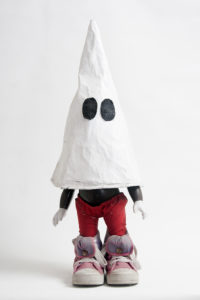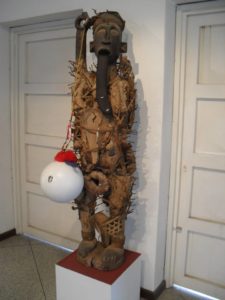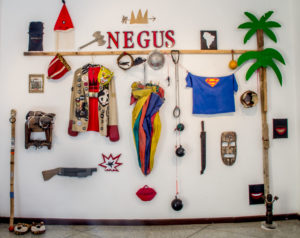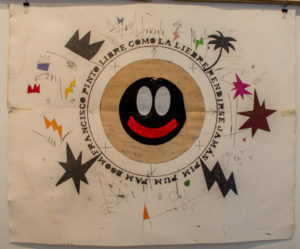
SONY DSC
Francisco Pinto in Museo de Arte Afroamericano. Caracas. Venezuela
Francisco Pinto, 1970, Caracas, lives and works in Caracas
An oceanic perspective
*
Francisco Pinto is a Caribbean man, from Venezuela. To understand his work we have to start with the sea, situate ourselves in an oceanic perspective: to open up to the Atlantic and to tie ropes from one continent to another, Africa, Europe, America.

*
To approach the first grandparents of Francisco Pinto: The Indian Caribbean that gave its name to the sea; the Portuguese grandfather who gave the same name to the artist: Francisco Pinto; of the administrator that Portugal sent to the Kingdom of Congo in 1882; The grandfather torn out of Africa by the Atlantic trafficking, which arrived nameless, and to whom Derek Walcott describes with pebbles under the tongue and the stars aligned in another way.

*
All over America the presence of the infamous ship that just crossed the river of oblivion. And all over America also the trail of metaphoric ships in literature, Oralitura, works of art-Barcopatineta, drama, music, dance moving towards the light and Federico García Lorca singing

*
The Mascaron. Look at the Mask
As it comes from Africa to New York.
What a wave of mud and fireflies over New York!
*
The image of the Fence of the Teeth, the song IX of the Iliad allows Francisco Pinto to baste the imagery of affliction and power, in an unexpected, humorous, playful.
The voraciousness of power in this case colonialism and slavery has been associated with the figure of devouring. Aimé Césaire picks up that thread and asks a heartbreaking question, do we, the Slave man’s vomit?

*
Francisco Pinto replies.
The word impeded, it becomes fluid, creative. Francisco invents his books of resistance, creates object-books in which he celebrates the academic researcher who, even in Sordina, delves into unattended realities.
*
I’ve seen him cradle those books, perhaps as the Bámbara might say
The beginning of all the beginning of the word is the crowned crane. The crowned Crane Bird says I speak.

*
Francisco Pinto has registered in his body the crown of the kings of Congo, the same crown that Jean-Michael Basquiat used as a rubric. It is the golden crown that the kings of Congo adopted not to emulate the European rulers but as part of a reflection on power and legitimacy, aroused from the dominion of the Kingdom of Portugal in Africa.
*
This reflection was given as a “correlation space”, a concept formulated by Cécil Fromont (2014), which seems to me to be the most fertile to envision the enormous sense and complexity of some cultural processes.

*
And so the memory of the ancient Kingdoms endures in America. In the burning crowns of the Cimarronería, kings of Palenque, Cumbes, Mambices and Quilombos.
The King of Harlem, the kings of dances and festivals-conga in Havana, Rio, Bahia, New York…
To F. Toussaint-Louverture of whom the primary education books in Haiti say:
This grandson of Kings lived over 40 years in slavery.
